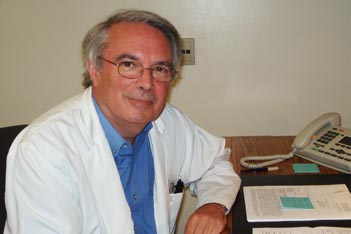The Acute Care Service - A Team Approach
The Divisions of General Surgery at Sunnybook and
St. Michael's Hospital have introduced a new organization
for the provision of emergency services called "The
Acute Care Service" (ACS). It is appropriate that we look
closely at this development as it marks a change in our
pattern of patient care. In the past a patient was admitted
to hospital and cared for by one particular surgeon
who looked after the patient for the whole hospitalization
and often frequently for re-hospitalizations. The
Acute Care Service replaces the single surgeon model
with the provision of care by a team. This type of care
has been ongoing for some time in the Department of
Medicine but I believe this is the first time it has been
done within the Department of Surgery here at the
University of Toronto.
 Robert Mustard |
The Acute Care Service consists of a rotating staff surgeon,
a senior resident - typically a PGY III, and one
or two junior residents along with one or two clinical
clerks. The staff surgeon usually changes every week and
the senior resident every two to three months. The ACS
is responsible for all consultations from the Emergency
Department, all in-patient consultations, and some if not
all referrals to the General Surgery Service from other
hospitals via CritiCall. The staff surgeon is typically also
responsible for the Trauma Team at the same time.
The staff surgeon is on call for emergencies Monday to
Friday from 8 until 5. Emergency patients admitted during
the night are initially admitted to the surgeon on call
that night and then transferred to the Acute Care Service
at 8 am the following morning.
Why was this change in organization of the Division of
General Surgery carried out?
Acute Care Services were initially started in the United
States five to ten years ago and have now moved to
Canada for basically the same reasons. General Surgery
has become increasingly sub-specialized and a considerable
number of academic general surgeons are no longer
comfortable with the management of the entire spectrum
of general surgical emergencies. A second driver
for the emergence of the ACS in the United States was
the malpractice system there. Emergency and trauma
patients account for a much larger than average proportion
of malpractice suites and many surgeons in the
United States wished to avoid that liability. On the other
hand, there also exist a significant number of general
surgeons who prefer to maintain a wide general surgical
practice that includes trauma surgery.
|
What are the advantages of this new system?
The main advantage to my mind is that it frees up all
the other general surgeons who are not doing acute
care at any particular time so that they may carry on
with their elective clinics, operating schedules and so
on, without disturbance by emergency consultations.
It also facilitates clinical research involving clinical
trials of patients with acute problems, as they are all
looked after by a single common service. The Acute
Care Service may also have some educational benefit
particularly for junior residents. A month or two on
the service gives them the opportunity of seeing a
large number and wide range of urgent general surgical
problems. On the other hand, the senior residents
on the service often complain that they don't get to
do as much operating as residents on other services.
The main disadvantage of this service is the sometimes
frequent change of most responsible physician. For
example, a patient with an adhesive bowel obstruction
might be admitted to Dr. A. at 10 pm on Friday night,
transferred to Dr. B. at 8 am on Saturday morning,
and then again transferred to Dr. C. at 8 am Monday
morning. The patients may have no idea who is actually
responsible for their care other than the resident
staff. The philosophy of management may also change
from day to day as the staff changes, and this is confusing
for the patient, the residents, and the nursing staff.
Finally, when a patient is admitted with a difficult
problem to the Acute Care Service, there can be an
unconscious tendency on the part of the staff surgeon
to procrastinate knowing that within a few days the
patient will be looked after by someone else and hence
the surgeon may be able to "dodge the bullet".
In conclusion, there are a number of strong positive
features to this system. It certainly benefits academic
general surgeons by allowing them the freedom to pursue
their specialized interests. It also ensures that emergency
patients are cared for expeditiously by surgeons who are
specifically interested in their type of problem. To my
mind, the main down side is the lack of continuity of
care of possibly complex patients. This can be remedied
by transferring such patients who will likely be in hospital
longer than about a week to the care of one specific
surgeon who specializes in their type of problem. This
surgeon might be the one who performed the initial
emergency surgery or may not. At any rate, it should be
very clear to all involved and most importantly to the
patient that they are now under the care of one specific
surgeon for the rest of their hospital course. This also
has the advantage of removing long stay patients from
the Acute Care Services and gives the residents better
experience of looking after truly emergency situations
rather than prolonged convalescence from more drastic
emergencies. If managed appropriately, I believe that
this system will be an overall benefit for the patients, the
residents and the staff.
Robert Mustard
|